Washing machines with a drying function are slowly but surely replacing classic models that only wash and spin clothes. Although this process takes time, users are increasingly choosing models with drying. Such machines save a lot of time, despite the fact that they cost about a third more.
Our test laboratory received another such model — Lex LWM08512WID. This is a full-size washing machine with a not very large, but quite sufficient set of programs.

Characteristics
| Manufacturer | Lex |
|---|---|
| Model | LWM08512WID |
| Type | front loading washer-dryer |
| Country of Origin | China |
| Guarantee | 36.6 months, motor — 8 years |
| Life time * | 10 years |
| Control | electronic |
| Display | There is |
| Drying function | There is |
| Number of programs | 12 |
| Antibacterial wash | There is |
| Drum cleaning function | There is |
| Steam wash | There is |
| Delayed start | up to 24 hours |
| Energy class | A+++ |
| Energy consumption per year | 205.7 kWh |
| Power | in spin mode — 520 W in washing mode — 200 W in drying mode — 1500 W |
| Washing class | A |
| Drying class | A |
| Spin | up to 1200 rpm |
| Maximum load | for washing — 8 kg for drying — 5 kg |
| Noise level | 60 dB(A) |
| Weight | 63 kg |
| Dimensions (W×H×D) | 850×595×600 mm |
| Network cable length | 1.5 m |
* Contrary to popular belief, this is not the time limit after which the device will necessarily break down. However, after this period, the manufacturer ceases to bear any responsibility for its performance and has the right to refuse to repair it, even for a fee.
Equipment
The washer dryer is supplied in a brown technical cardboard box. The insides are protected with foam liners, and the box is covered with durable polyethylene tapes.
The sides of the box depict the car in vector style and list its main technical characteristics.

The washing machine kit includes:
- hose for connection to water supply
- hose for connecting to the sewerage system (installed on the machine)
- set of plugs for transport holes
- metal key
- sticker with data on the energy efficiency of the device
- user guide

At first sight
The layout of the washing machine is classic: in the upper left corner there is a container for detergents, and to the right of it there are controls.
The appearance of the car combines modernity with notes of retro style. This is achieved through physical buttons instead of touch ones, as well as a digital display with yellow backlighting. Let us immediately note that we liked this solution, and here’s why...
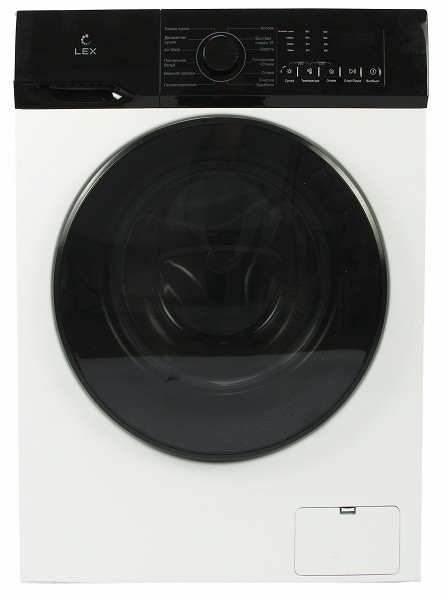
The display is made of black plastic. In the center there is a rotating knob (program selector). On the right are indicators for drying, temperature and spin, and further away is a digital display. There are buttons at the bottom.
The indicators and digital display are backlit in bright orange, creating a warm and cozy feeling, especially compared to the blue LED backlighting that is popular today. The brightness is sufficient to easily see the selected mode. Regular (non-touch) buttons allow you to quickly select the desired mode without being distracted by the display readings. Tactile clicks are clearly felt, eliminating the need for the user to listen to beeps or watch indicators light up.

The detergent compartment is standard for Lex washing machines. On the left is a tray for washing powder or liquid detergent and bleach. On the right is the soak compartment and behind that is the conditioner compartment. This model does not have special trays or facilities for liquid detergents. The tray is secured with a blue latch and can be easily removed for cleaning and maintenance.

The drum cover is edged with a decorative strip of gray matte plastic. The hatch is two-layer: transparent plastic on the outside and glass on the inside.
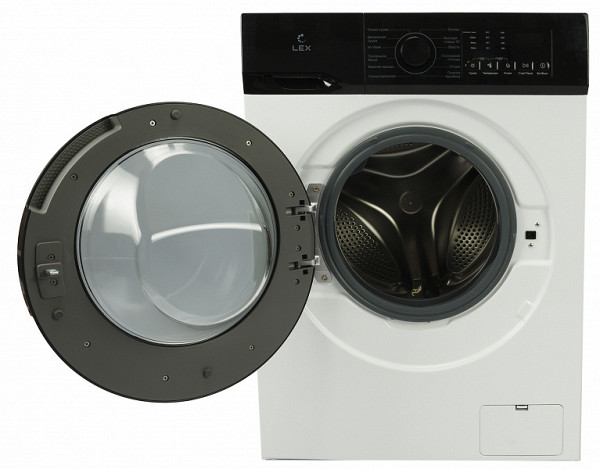
The hatch hinges on this model are made of metal and allow you to open the door to an angle of approximately 150°. The lock retainer is made of silumin, and the counterpart of the latch is made of plastic. It will not be possible to rearrange the door so that it opens in the other direction, since this is not provided for by the design.

The perforation on the drum is located both around the perimeter and on the end wall. There are special plastic slots installed on the side surfaces, which provide the best mixing of the contents of the drum and uniform access of water to the entire volume of laundry during the washing process.

In the lower right corner of the front panel there is a hinged hatch, under which there is an exhaust filter plug. Although you will not need to look here often, if the filter becomes clogged, it will be easy to remove and clean.

The side walls are stamped to increase rigidity and give the machine a more stylish look.

The drain hose is already installed and secured in special holders on the rear panel. In the upper left corner there is a socket for the inlet hose with a mesh filter for rust protection. Like most washing machines, this model is designed only for connection to cold water supply.

During transportation, the drum is secured using four screws with plastic plugs and shock absorbers made of dense black rubber. After installing the machine in place, you need to unscrew these screws and close the holes with the plastic plugs provided in the box.
What's inside?
According to established tradition, we carry out partial disassembly of the washing machine, removing the top chipboard cover and the back panel, and photograph its main components without commenting on what we see.


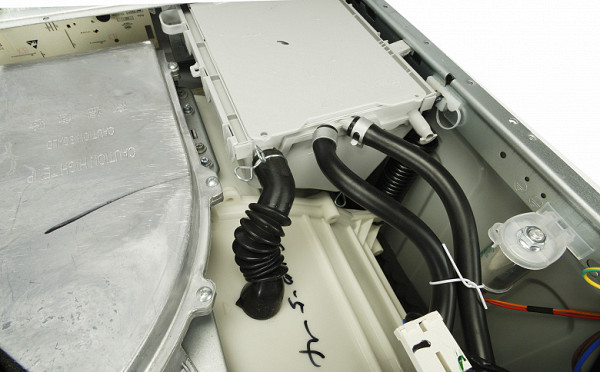



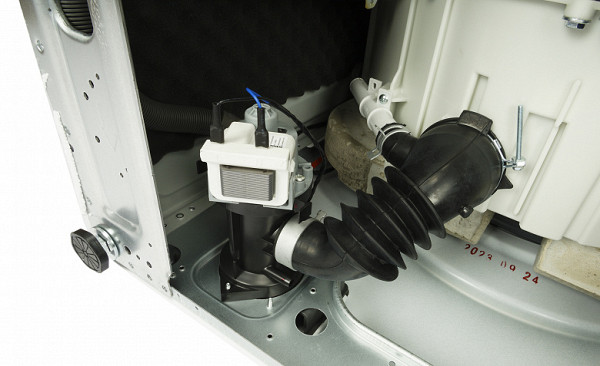


Instructions
The user manual is a 36-page A5 booklet, printed on high-quality white paper with excellent printing. All figures, diagrams and tables, of which there are quite a lot, are easy to read without stress. The document is written in Russian.

From the brochure you can learn all aspects of preparing the machine for operation, features of its operation, detailed information on product care and safety measures during use. Finally, a list of possible faults is presented with recommendations for eliminating them yourself.

Management
The cylindrical selector on the left side of the control panel allows you to select the main washing programs. The tick mark indicates the selected script (program).

When the program ends, the selector does not change position.

Mode information is displayed on a black display with a bright yellow LED indication. The numbers and indicator lamps are contrasting and easy to read in any lighting and from any viewing angle. Visually it looks very impressive!
When you select a program, the display shows the expected operating time. When changing the temperature and spin settings, the time is automatically adjusted in accordance with the selected washing parameters.
Below the display there are buttons that control additional washing options. There are only five of them on the car:
- Drying: Sets the drying time (30, 60 or 120 minutes), smart dry mode is also available.
- Temperature: Sets the washing water temperature (20, 40, 60 or 90°C).
- Spin speed: selects the spin speed (1200, 1000, 800 or 600 rpm).
- Start/Pause: Starts or pauses the program.
- On/Off: Turns the machine on or off.
Please note that the machine automatically blocks the ability to set parameters that do not correspond to the selected program. For example, when selecting the “Wool” mode, you cannot set the temperature to 60 or 90°C, and high spin speeds are not available for the “Delicates” mode. Moreover, in most programs you cannot disable the spin mode, but you can only select its speed from the proposed options.
Pressing the temperature and spin buttons simultaneously activates or deactivates the child lock feature. And by simultaneously pressing the “Drying” and “Temperature” buttons, you can set a delayed start of up to 24 hours in 1-hour increments.
The table shows the default values for each program and the range of possible manual settings.
| Program | Default water temperature, °C | Possibility of temperature change, °C | Program duration in standard mode | Default spin, rpm | Possibility of changing the spin speed, rpm | Possibility of selecting drying mode 30/60/120 minutes/intelligent drying |
|---|---|---|---|---|---|---|
| Drying only | − | − | 1:54 | − | − | + |
| Delicate drying | − | − | 1:44 | − | − | + |
| Air Wash | − | − | 0:30 | − | − | |
| Bed sheets | 40 | 60/40/20/no heating | 1:12 | 800 | 1000/800/600 | + |
| Outerwear | 40 | 40/20/no heating | 1:08 | 800 | 800/600 | − |
| Hypoallergenic | 60 | − | 1:59 | 800 | 1000/800/600 | + |
| Cotton | 40 | 90/60/40/20/no heating | 0:55 | 800 | 1200/1000/800/600 | + |
| Quick wash | without heating | − | 0:15 | 800 | 800/600 | + |
| Wool | without heating | 40/20/no heating | 0:43 | 600 | 800/600 | − |
| Rinse+spin | without heating | − | 0:16 | 800 | 1200/1000/800/600 | + |
| Spin | without heating | − | 0:10 | 800 | 1200/1000/800/600 | + |
| Cleaning the drum | 60 | − | 1:15 | 800 | − | − |
As you can see, our model offers a limited number of programs for different types of fabrics. However, standard programs such as Cotton allow extensive customization. There is also a quick mode (15 minutes in cold water), a program for washing outerwear, a wool mode and a special Air Wash function designed for disinfection and deodorization using hot air.
This set of programs is ideal for those users who prefer to use only 2-3 of the most popular programs and do not want to dive deeply into the settings.
Changing settings is accompanied by a sound signal. At the end of the wash, the machine also emits a characteristic sound signal and repeats it several times after a short pause to be sure.
Exploitation
Connecting the washing machine to the water supply and sewerage went without problems, since all connections were standard. The main condition before starting work is to unscrew the transport bolts that secure the drum.
We strongly recommend that the machine is properly leveled to avoid vibrations and movement on the floor. To do this, it is necessary to adjust the height of the legs using a building level.
When installed correctly, the machine operates quite quietly according to subjective sensations. The model is well balanced and, when properly aligned, stands stable and secure. During testing, the car showed no attempts to “escape” or move.
Before first use, it is recommended to run the Drum Cleaning program in empty mode.
When you select a program, the display shows the exact operating time of the machine in this cycle. At the initial stage of washing, the time can be slightly adjusted. Increasing the temperature before starting the program leads to a corresponding increase in operating time.
The door will unlock immediately after the wash is completed and a beep sounds. The program completion message appears a second or two after the drum stops and the lock clicks.
Care
The detergent container must be removed regularly and washed in warm water.
The drum door seals are also susceptible to contamination, so they should be wiped with a damp cloth and checked from time to time.
The manufacturer recommends cleaning the washing machine filter at least two to three times a year. If the machine does not drain water normally, does not spin properly, or foreign objects are found in the tank, the first thing to do is check the condition of the filter.
Our measurements
When estimating the capacity of a washing machine drum, we assume its shape to be approximately a cylinder. In our model, the tank has a radius of about 24 cm and a depth of about 34 cm. This gives a volume of about 61,494 cubic centimeters, which corresponds to approximately 61.5 liters.
We also tested the main mode using a stopwatch (standard Cotton program at a set temperature of 40 degrees).
| Actual time until end | Countdown on display | Action | Total water consumption, l |
|---|---|---|---|
| 0:56 | 0:55 | program launch | |
| 0:55 | 0:55 | drum rotation | |
| 0:54 | 0:50 (time correction) | flood of water | 10 |
| 0:53 | 0:49 | start of washing | |
| 0:37 | 0:33 | drain | |
| 0:37 | 0:31 | spin | |
| 0:35 | 0:27 | flood of water | 27 |
| 0:28 | 0:26 | fast drum rotation | |
| 0:25 | 0:23 | drain/slow drum rotation | |
| 0:23 | 0:21 | spin | |
| 0:16 | 0:16 | slow drum rotation | |
| 0:15 | 0:14 | rinsing/filling with water | 43 |
| 0:11 | 0:10 | drain | |
| 0:10 | 0:09 | drain/slow drum rotation | |
| 0:09 | 0:08 | spin | |
| 0:01 | 0:01 | slow drum rotation/stop | |
| 0:00 | End | drum unlock |
Energy and water consumption
Unfortunately, these parameters are usually not indicated in the instructions or are not given in very detail and accurately. Therefore, we offer you measurement results for the programs that were used during our testing.
| Program | Amount of water, l | Electricity consumption, kWh |
|---|---|---|
| Cotton, 40 °C | 43 | 0.315 |
| Cotton, 90 °C | 47 | 1.316 |
| Bed sheets | 51 | 0.486 |
| Express (15 minutes) | 28 | 0.017 |
| Wool | 6 | 0.378 |
| Outerwear | 53 | 0.574 |
| Air Wash | 6 | 0.415 |
| Hypoallergenic | 49 | 1.281 |
| Rinse+spin | 21 | 0.016 |
| Dry only (smart dry) | 25 | 1.985 |
| Dry only (30 minutes) | 6 | 0.504 |
| Spin (800) | — | 0.021 |
Note that the washing machine is not very economical in water consumption, especially in modes such as “Bed linen” or “Outerwear”, which can be a slight disadvantage. In our opinion, this is rather a plus: thanks to this, the laundry will be thoroughly washed and rinsed, which ultimately does not greatly affect utility bills.
Spin and dry
Another standard test we perform is an assessment of actual spin efficiency, measured in grams of water per gram of cotton using the formula: (weight of laundry pressed minus dry weight) divided by dry weight. As reference linen, we used 10 terry white towels with a total weight of about 2 kg.
| Spin speed, rpm | Remaining water per gram of dry laundry, g |
|---|---|
| 600 | 1.26 |
| 800 | 0.90 |
| 1000 | 0.73 |
| 1200 | 0.62 |
In practice, this means that after spinning at 600 revolutions, our towels with an initial weight of 2 kg began to weigh 4520 g. After spinning at 1200 revolutions, their weight was already 3243 g.
This was followed by 30-minute drying cycles, which reduced the weight of 2kg of laundry first to 2836g, then to 2466g, and then to 2050. A 30-minute drying cycle consumed 0.52 kWh of electricity. The Smart Dry mode dried our 2kg test cotton perfectly.
Noise
We measured the noise level in the bathroom, where washing machines most often work. The sound level meter was placed at a height of 1 m from the floor and at a distance of 1 m from the front panel of the car, in the center.
| Operating mode | Noise level, dBA |
|---|---|
| Wash | 49 |
| Drain | 47 |
| Intermediate spin | 58 |
| Rinsing | 46 |
| Final spin 1200 rpm | 62 |
The maximum power consumed by the machine, recorded during practical tests, was 1616 W. In standby mode, the washing machine consumes less than 0.1 W.
Practice tests
To evaluate the basic function of the washing machine, we used white terry cotton towels. They were coated with common and difficult-to-remove organic contaminants and then left to dry for 24 hours. Washing was carried out using standard modes, the results were recorded before and after.
Red wine

Ketchup

Soy sauce
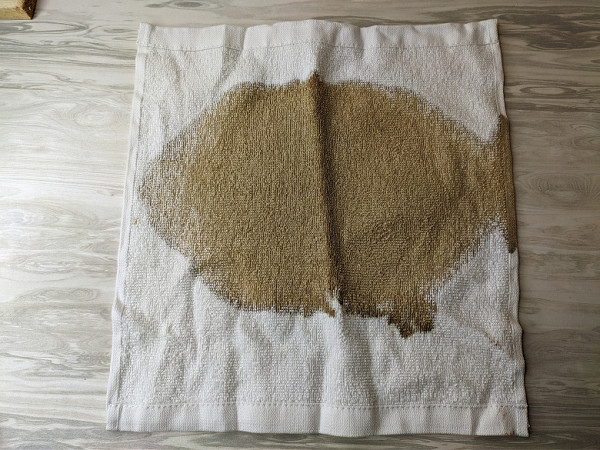
Cocoa
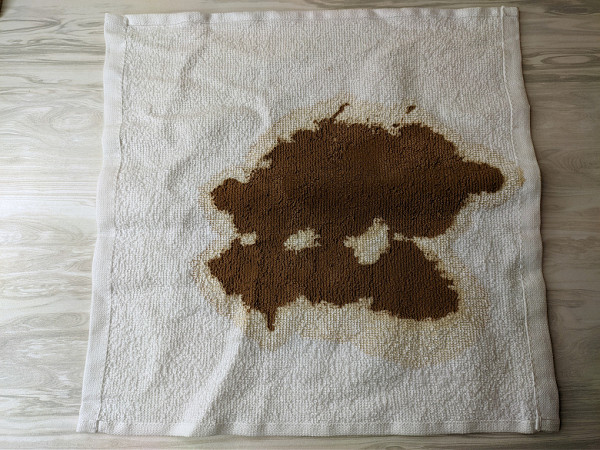
We applied one of the common and wash-resistant stains to each of the towels: red wine, soy sauce, ketchup and cocoa. After drying for 24 hours, the towels were placed in the washing machine. We added white laundry gel from a reputable manufacturer to the detergent tray, measuring the dosage according to the instructions on the package.
Cotton, 40 °C
Our first test is the standard Cotton program with a temperature of 40 °C. The result is presented below.
Red wine was the worst to clean up. The marks are visible to the naked eye.
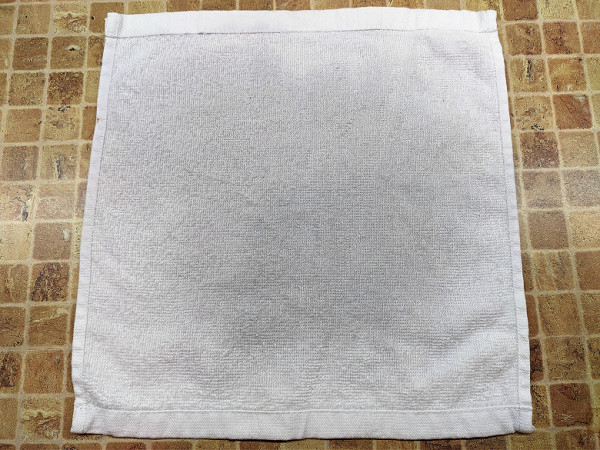
The cocoa left only minor stains.
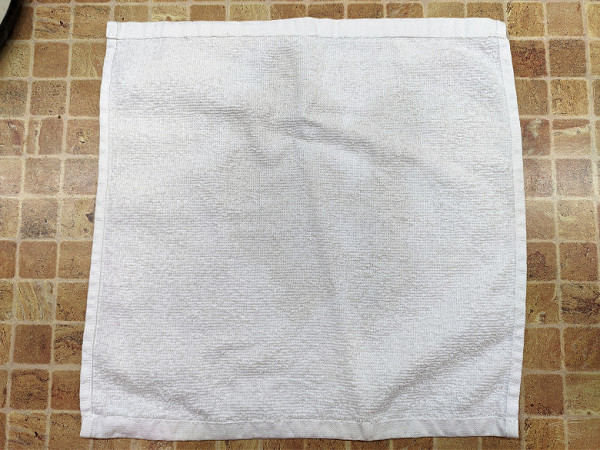
The ketchup and soy sauce came off perfectly.
Result: excellent
Cotton, 90 °C
Well, let's see what happens to similar napkins that we wash at 90 degrees...
Traces of wine were barely noticeable.
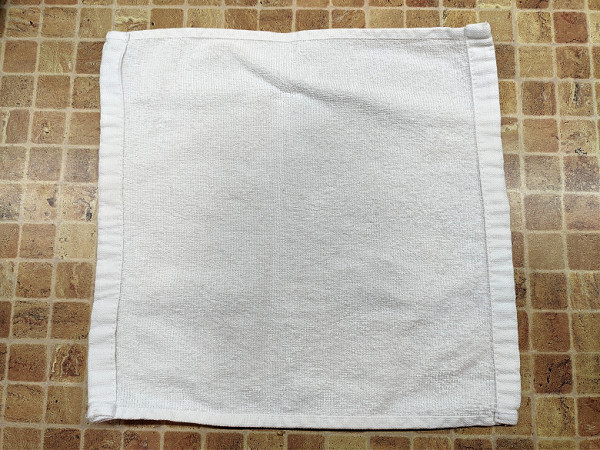
Traces of cocoa can be seen only by specially and very carefully examining the towels
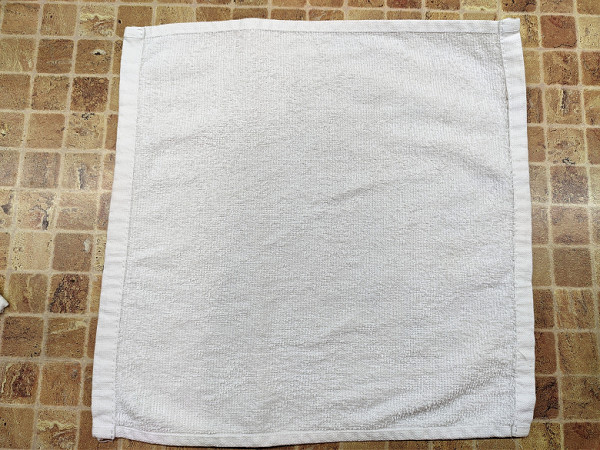
Ketchup and soy sauce disappeared without a trace.
Result: excellent
Wool
Our third standard test involved washing a wool blanket on a program designed specifically for wool. Our blanket weighs just under one kilogram and we used the Wool program on the default settings to wash it.
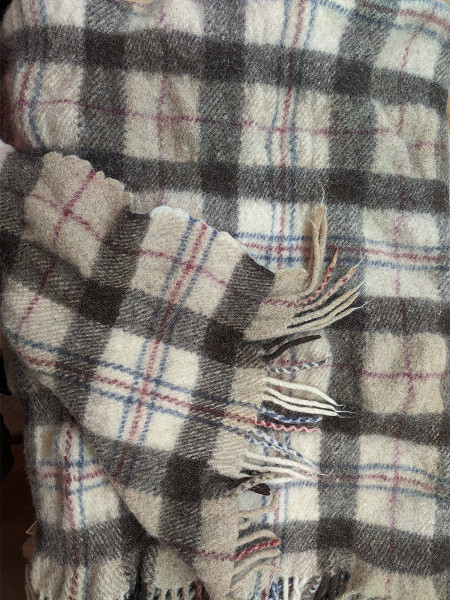
We got an excellent result again. After washing, the blanket remained in its original size, without pilling or compaction, and without visible traces of dirt. The optimal spin speed (600 rpm) was sufficient to ensure that the blanket was only slightly damp when removed from the drum. Indoors using a dryer it will dry in 2-3 hours.
Result: excellent
conclusions
A page of our impressions about the Lex LWM08512WID washing machine. It performed flawlessly in our tests, confirming its excellent reputation. The drying function turned out to be especially useful, saving time and space in the apartment.
Among the bright sides, we highlight the stylish design, maximum spin speed of up to 1200 rpm, as well as high quality washing and rinsing. A small nuance — the average water consumption is slightly higher.

The disadvantages include the relatively small number of available programs. Some of them do not allow you to tamper with the settings, and those that allow adjustments offer only limited options. In theory, this is correct: this way we will not ruin things by accidentally selecting the wrong mode. However, sometimes you want, for example, to turn off the spin cycle, but this option may not be available. The noise level also turned out to be slightly above average, although subjectively this was insignificant and during testing the machine did not cause us any inconvenience.
Pros:
- simple controls
- good washing quality
- excellent drying function
- relatively high water consumption (which means better washing and rinsing quality)
Minuses:
- relatively small set of programs
- relatively high water consumption (may be important for those who save water or care about the environment)




